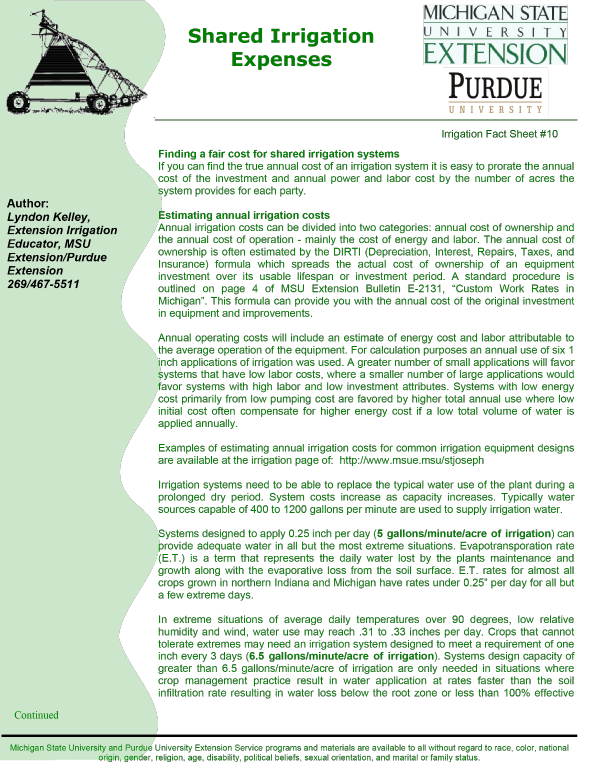
Bulletin Irrigation Fact Sheet #10
Shared Irrigation Expenses
DOWNLOAD
February 1, 2010 - Lyndon Kelley, Michigan State University Extension
Finding a fair cost for shared irrigation systems
If you can find the true annual cost of an irrigation system it is easy to prorate the annual cost of the investment and annual power and labor cost by the number of acres the system provides for each party.
Estimating annual irrigation costs
Annual irrigation costs can be divided into two categories: annual cost of ownership and the annual cost of operation - mainly the cost of energy and labor. The annual cost of ownership is often estimated by the DIRTI (Depreciation, Interest, Repairs, Taxes, and Insurance) formula which spreads the actual cost of ownership of an equipment investment over its usable lifespan or investment period. A standard procedure is outlined on page 4 of MSU Extension Bulletin E-2131, “Custom Work Rates in Michigan”. This formula can provide you with the annual cost of the original investment in equipment and improvements.
Annual operating costs will include an estimate of energy cost and labor attributable to the average operation of the equipment. For calculation purposes an annual use of six 1 inch applications of irrigation was used. A greater number of small applications will favor systems that have low labor costs, where a smaller number of large applications would favor systems with high labor and low investment attributes. Systems with low energy cost primarily from low pumping cost are favored by higher total annual use where low initial cost often compensate for higher energy cost if a low total volume of water is applied annually.
Examples of estimating annual irrigation costs for common irrigation equipment designs are available at the irrigation page of: http://www.msue.msu/stjoseph
Irrigation systems need to be able to replace the typical water use of the plant during a prolonged dry period. System costs increase as capacity increases. Typically water sources capable of 400 to 1200 gallons per minute are used to supply irrigation water.
Systems designed to apply 0.25 inch per day (5 gallons/minute/acre of irrigation) can provide adequate water in all but the most extreme situations. Evapotransporation rate (E.T.) is a term that represents the daily water lost by the plants maintenance and growth along with the evaporative loss from the soil surface. E.T. rates for almost all crops grown in northern Indiana and Michigan have rates under 0.25” per day for all but a few extreme days.
In extreme situations of average daily temperatures over 90 degrees, low relative humidity and wind, water use may reach .31 to .33 inches per day. Crops that cannot tolerate extremes may need an irrigation system designed to meet a requirement of one inch every 3 days (6.5 gallons/minute/acre of irrigation). Systems design capacity of greater than 6.5 gallons/minute/acre of irrigation are only needed in situations where crop management practice result in water application at rates faster than the soil infiltration rate resulting in water loss below the root zone or less than 100% effective water use. See fact sheet “Reducing and evaluating irrigation runoff” at the website above.
There are tremendous differences in cost of establishing irrigation. Several factors can lead to low water source cost (less than $15,000). Factors leading to high water source cost (greater than $50,000) are the reciprocal of what is listed:
- productive water tables are close to the surface (less than 40 feet)
- riparian rights to a dependable surface water option adjacent to field
- ample three phase electric power is readily available near the pumping site
- system is designed for moderate to low pumping pressure
- Hills and Steep slopes may require higher pressures and large wetted areas to reduce chance of run-off.
Several factors can lead to low distribution equipment costs which can be achieved with the right combination of the following:
- Total size of irrigated areas - the bigger the system the lower the cost
- Shape of the irrigated areas -160 acre squares are hard to beat
- Three phase electric power is readily available near control panels
- Flat topography - hills and slopes require shorter pivot spans to maintain crop clearance.
Example: dividing cost for a 1320 foot (standard 160 pivot) between two owners
The 160 area in question can be cover by a 1320 foot (standard 160 pivots). Owner A has 120 acre of the area and owner B. has 40 acres. Actual irrigated area is 132 total acres with owner A having 99 acres of irrigated land and Owner B having 33 acres.
The annual cost of ownership is estimated at $95.64 per acre and the annual operating cost is estimated at $4.36 per acre inch or $30.50 per acre for a seven inch application year.
A common proposal for a fair sharing of cost would be Owner A. purchase and installs the well, pivot and infrastructure on his property, situated to cover both properties. Owner B would pay annually $3,156 (33 acre * 95.64 per acre) to cover annual ownership cost of the portion of the machine that covers his 33 acres of irrigated land. Owner B would also compensate owner A. for energy cost. $1,060 ($30.50 per acre for a seven inch application year. * 33 acres of actual irrigated land).
Owner A would be responsible for the total original equipment and installation cost along with annual energy, insurance tax (if applicable) and repair costs.
At the end of the ten year agreement owner A would retain the equipment. An extended agreement could be drafted using the salvage values in place of new equipment cost at that time.



 Print
Print Email
Email


